History - The Motor Lifeboats
During 129 years the rowing lifeboats at Redcar had been launched over 100 times and saved more than 740 lives.
The advantage of motor lifeboats was clearly illustrated on February 25th, 1933, when the Louisa Polden was called out for the first time.
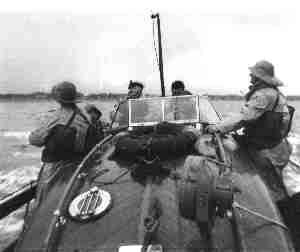 Around midnight she was launched to search for the collier Sheaf Arrow, which had asked for immediate assistance. A severe gale was blowing from the ESE, it was snowing heavily, and a heavy sea was running. The lifeboat crew spent six hours searching for the collier, not knowing that the distress signal had been cancelled and that she had put into the Tyne. It would have been impossible to cover the same area in such conditions in a rowing lifeboat. Around midnight she was launched to search for the collier Sheaf Arrow, which had asked for immediate assistance. A severe gale was blowing from the ESE, it was snowing heavily, and a heavy sea was running. The lifeboat crew spent six hours searching for the collier, not knowing that the distress signal had been cancelled and that she had put into the Tyne. It would have been impossible to cover the same area in such conditions in a rowing lifeboat. |
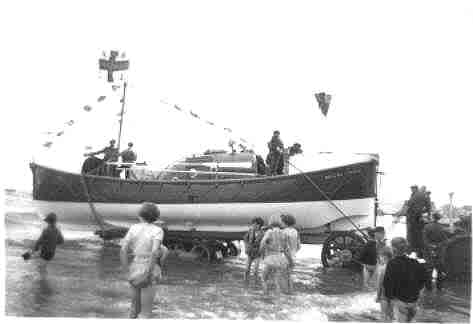 In 1951 the Louisa Polden was replaced by the City of Leeds, a larger self-righter, powered by twin 20 h.p. diesel engines. The City of Leeds served for 14 years at Redcar and saved 31 lives, being launched on service 52 times. Probably the most notable launch was in 1952 to the Greek steamship Taxiarchis. The Taxiarchis struck the Westscar rocks. Despite attempts ro refloat her, the Taxiarchis was finally beached and dismantled for scrap. In 1951 the Louisa Polden was replaced by the City of Leeds, a larger self-righter, powered by twin 20 h.p. diesel engines. The City of Leeds served for 14 years at Redcar and saved 31 lives, being launched on service 52 times. Probably the most notable launch was in 1952 to the Greek steamship Taxiarchis. The Taxiarchis struck the Westscar rocks. Despite attempts ro refloat her, the Taxiarchis was finally beached and dismantled for scrap. |
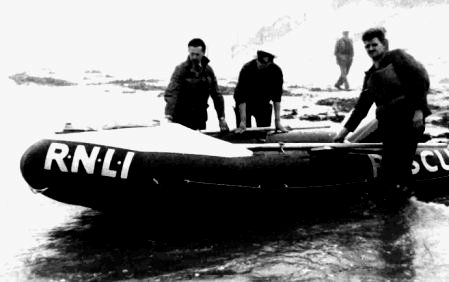 A massive increase in leisure boating during the 1950s and ’60s, caused a corresponding increase in the number of calls made on lifeboats. It was obvious that a new type of lifeboat was needed, smaller and faster than the conventional type, yet still able to operate in relatively rough conditions. The answer was found in an inflatable boat of about l6ft., powered by an outboard motor, and capable of speeds up to 28 knots. A massive increase in leisure boating during the 1950s and ’60s, caused a corresponding increase in the number of calls made on lifeboats. It was obvious that a new type of lifeboat was needed, smaller and faster than the conventional type, yet still able to operate in relatively rough conditions. The answer was found in an inflatable boat of about l6ft., powered by an outboard motor, and capable of speeds up to 28 knots. |
In 1963 Redcar received one of the first of these inshore rescue boats for evaluation trails. At that time the protective clothing was the same as that for the off-shore boat crew. That meant that even on the calmest of days the entire service call had to be endured wearing a pair of thigh length waders full of sea water and clothing which became saturated within minutes.
Despite this, the trials were a huge success, and the latest generation of this boat is to be found stationed all around the coast.
During 1972 a new lifeboat-house was completed at Redcar and an Oakley type lifeboat, Sir James Knott, arrived on November 28th. An official opening ceremony was performed by the Marquis of Zetland on Monday, May 28th, 1973, and the lifeboat was re-dedicated by the Bishop of Whitby.
At approximately 16.00 on October 4th, 1981, the lifeboat-house attendant at Redcar observed a 15ft. speed boat being launched into rough seas from the foot of the lifeboat slipway. The speed boat headed straight towards West Scar, a reef of outlying rocks, and at 16.10 was seen to be capsized by a large wave.
 A crew of the I.L.B. was assembled and at 16.17 the I.L.B. was launched with helmsman Trevor Wilberforce and crewman Dave Cocks on board. Several heavy seas were shipped during launching and waves of up to fifteen feet in height were breaking along the entire length of the outlying rocks. As a considerable detour was necessary to avoid the danger, full speed was maintained despite the very rough conditions. A crew of the I.L.B. was assembled and at 16.17 the I.L.B. was launched with helmsman Trevor Wilberforce and crewman Dave Cocks on board. Several heavy seas were shipped during launching and waves of up to fifteen feet in height were breaking along the entire length of the outlying rocks. As a considerable detour was necessary to avoid the danger, full speed was maintained despite the very rough conditions. |
Beyond the rocks the I.L.B, was frequently hidden from sight by large waves. As the wind was nearing gale force and visibility was poor it was decided to place the offshore lifeboat on stand by, and a crew was assembled at 16.25. At about the same time the two men from the speedboat were sighted briefly from the I.L.B. as it rose on the crest of a wave. They were in the water and clinging to an empty fuel drum. Both were wearing wetsuits but not lifejackets.
One was a non-swimmer and was in a state of exhaustion. Trevor Wilberforce worked the I.L.B. through the breakers until it was alongside, and Dave Cocks pulled the fittest survivor on board. They clung to the exhausted man whilst the I.L.B. was turned to meet the seas and avoid a possible capsize, and then he too was hauled aboard.
Both men were in poor shape through hypothermia and exhaustion and an ambulance was requested and was waiting to meet the I.L.B. when it was beached at 17.00.
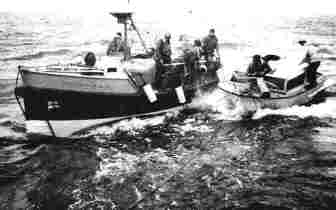 Early on Friday, November 12th, 1982, the l7ft. 6in. fishing boat Lady Therese was seen leaving Redcar, and, as it was a rough morning, a watch was kept on her from the lifeboat-house. Early on Friday, November 12th, 1982, the l7ft. 6in. fishing boat Lady Therese was seen leaving Redcar, and, as it was a rough morning, a watch was kept on her from the lifeboat-house. |
At 12.13 the boat was about a mile north east of the lifeboat station, and looked as though she needed help. Coxswain David Buckworth informed Tees coastguard and the station honorary secretary of the situation, and at 12.21 the Sir James Knott was launched from her carriage.
A gale to strong gale, force 8 to 9, gusting at times to storm force 10, was blowing from the south west and the sea was rough. It was one hour after high water. Coxswain Buckworth brought the lifeboat alongside the fishing boat at 12.33, and the four occupants were transferred to the lifeboat. A tow was then rigged, and the lifeboat and Lady Therese reached Redcar at 12.50.
For this service a letter of appreciation signed by Rear Admiral Graham, director of the RNLI, was sent to coxswain David Buckworth and his crew.
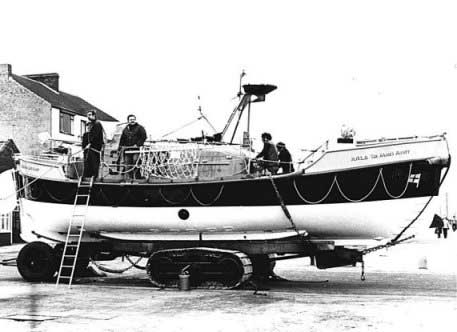 At 23.33 on Monday, June 4th, 1984, Tyne Tees coastguard informed the honorary secretary that the crane barge Kerrydale H, with five crew on board, had experienced machinery failure and was adrift 3.75 miles ENE of the lifeboat station. The tug Ralph Cross was leaving the Tees to give assistance, but as it would be some time before it reached the Kerrydale H, the coastguard requested that the lifeboat should stand by. At 23.33 on Monday, June 4th, 1984, Tyne Tees coastguard informed the honorary secretary that the crane barge Kerrydale H, with five crew on board, had experienced machinery failure and was adrift 3.75 miles ENE of the lifeboat station. The tug Ralph Cross was leaving the Tees to give assistance, but as it would be some time before it reached the Kerrydale H, the coastguard requested that the lifeboat should stand by. |
At 23.50 the Sir James Knott was launched from her carriage under the command of second coxswain/mechanic John Price. The wind was NE5-6, visibility was poor, and the sea was rough with a moderate swell.
Contact was made with the barge at 00.23. It had already drifted some distance from its original position and with the strong onshore wind it was estimated that it would be aground in 2 hours. One of the crew was suffering from seasickness and the captain requested that he be taken on board the lifeboat, so as to save time if the barge had to be abandoned.
As preparations were being made to go alongside, the wind eased and the rate of drift decreased. It was decided to leave the man on board the barge, and the lifeboat continued to stand by until the tug arrived and a tow was rigged. The barge was towed into the Tees escorted by the lifeboat, which returned to her station at 05.00.
On Saturday, July 13th 1985 the Sir James Knott sailed for Amble for modifications. Unbeknown to the crew, it was to be the last time the Oakley was to serve at Redcar.
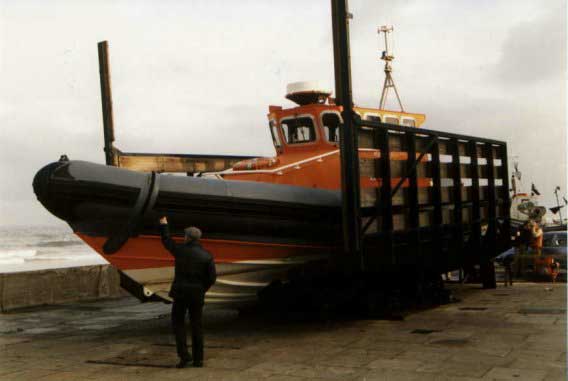 During a brief period with an Oakley from the reserve fleet, Redcar was chosen to help evaluate the prototype semi-rigid Medina class lifeboat. Powered by twin 350hp Caterpillar engines the Medina was capable of 28 knots using “jet” drives delivering a tonne of water per second to the nozzles at the rear of the boat. Sadly nothing was to become of this type of lifeboat although variants can be seen operating on the continent. During a brief period with an Oakley from the reserve fleet, Redcar was chosen to help evaluate the prototype semi-rigid Medina class lifeboat. Powered by twin 350hp Caterpillar engines the Medina was capable of 28 knots using “jet” drives delivering a tonne of water per second to the nozzles at the rear of the boat. Sadly nothing was to become of this type of lifeboat although variants can be seen operating on the continent. |
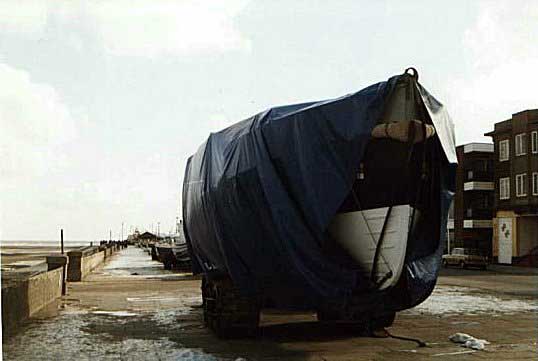 On the 11th November 1985 members of the R.N.L.I.’s Search and Rescue Committee visited the Redcar station to break the news that early in 1986 Redcar was to receive an Atlantic 21, ending a 184 year history of “big boats”. The news was met with dismay by some of the crew and with anticipation of a new challenge by others. Redcar became an “Atlantic 21” station on Sunday 22nd March 1986. The Sir James Knott unceremoniously left Redcar on the back of a heavy truck the following day. On the 11th November 1985 members of the R.N.L.I.’s Search and Rescue Committee visited the Redcar station to break the news that early in 1986 Redcar was to receive an Atlantic 21, ending a 184 year history of “big boats”. The news was met with dismay by some of the crew and with anticipation of a new challenge by others. Redcar became an “Atlantic 21” station on Sunday 22nd March 1986. The Sir James Knott unceremoniously left Redcar on the back of a heavy truck the following day. |